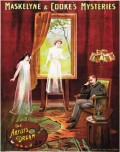Artist’s Dream
Designer: David Devant
Artist’s Dream is a simple story of an artist who paints a portrait of his deceased wife. He shows the portrait front and back. The artist tires of his painting and pulls a curtain over the front. The painting then “comes to life” and the assistant is produced. The background of the painting can be clearly seen and the assistant once more “returns” to the painting which is then again shown front and back.
Artist’s Dream was created by David Devant in 1893. Devant had created a large framework cabinet called “Vice Versa” for changing a man into a woman. When Devant joined John Nevil Maskelyne at the Egyptian Hall, Maskelyne pointed out that Devant’s apparatus was too large for tiny stage. In Steinmeyer’s Art and Artifice, Steinmeyer says that “Devant returned five days later with a small model of a new illusion, a creative adaptation of Vice Versa. He suggested an artist’s studio in which the picture came to life.” The Artist’s Dream was scripted by Mel. B. Spurr. It premiered on September 4, 1893 with Devant as the artist and his wife, Miss Marion Melville, as the dream-picture. After Devant’s retirement, Cecil Lyle toured it using the original apparatus.
Alexander Herrmann developed his own version and performed it in 1895 in the United States. Later in the 1940s, the Thayer Magic Company produced a version of the effect.
Jim Steinmeyer produced an updated Artist’s Dream effect for the Pendragons which he called Artist’s Daydream.
Michael Grandinetti added the use of light and shadows to produce his Life Size Portrait To Life illusion.

